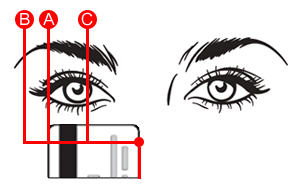home / find your ideal size
find your ideal size
HOW DO I FIND THE FRAME SIZE OF MY VELOCITY SUNGLASSES AND EYEGLASSES?
This guide explains how to choose the right sunglasses or eyeglasses size by either the measure of the lens or by looking at your current shades.*
*This guide is efficient for Velocity Aviator sizes, Velocity Wayfarer sizes, Velocity Clubmaster sizes and all Velocity models.
Important note: for the great majority of people, more then 90% of our customers, Standard Size is the correct one. It’s very likely it’s going to be the correct size for you too.
If this is your first pair of Velocity, a rule of thumb to determine the correct size for you is the following.
FIND YOUR FIT

This is the approximate width of a Standard Size lens.

In front of a mirror or a webcam, place one edge of the credit card at the center of your nose. Where does the other edge end?

A. If the edge of the credit card ends at the end of the eye your fit should be Standard Size.
B. If the card extends well beyond the end of the eye you should get a Large Size.
C. If instead the credit card does not reach the end of the eye then go for a Small Size.
WHAT ARE THE NUMBERS ON MY EYEGLASSES AND SUNGLASSES FRAME?
If you have a pair of Velocity and you want to know what the numbers printed inside the temples mean, here you will find an explanation.
The measurements need not be exact, they change from model to model, but the closer they are to those of your old glasses, the more the new ones will look similar on your face.

Most of our sunglasses and eyeglasses have the size measurement printed on the inside of the left temple (the piece that goes behind your ear). This usually consists of three numbers – sometimes only the first two are printed – similar to this: 50 20 150.
The third number in the sequence represents the temple length, it is the measurement in millimeters of the ‘arms’ of the frame.

The width of the lens is the first number in (50-20-150). The front measurement includes the diameter of the lens and the width of the bridge measured in millimeters and usually separated by a small dash or rectangle (e.g.: 50 – 20).
The lens diameter is the width of the lens, measured from the bridge, and the width of the bridge is the distance between the lenses above the nose, as shown in the figure below. Sometimes, the vertical measurement of the lens and the length of the arms are also present

Bridge width is the second number in (50-20-150). Typical widths are 12-26 millimeters. The bridge measurement is the distance between the lenses.The third number in the sequence represents the temple length, it is the measurement in millimeters of the ‘arms’ of the frame.

